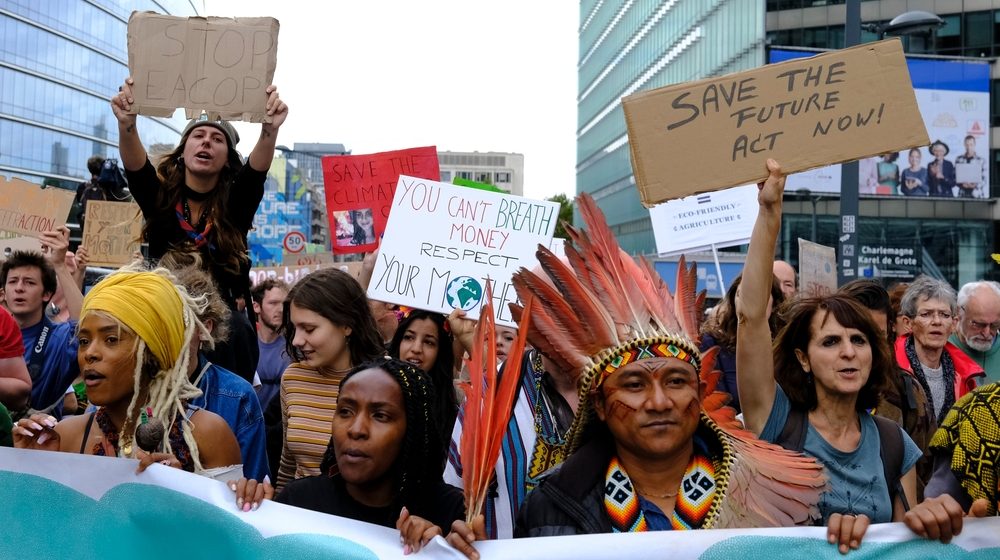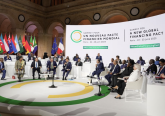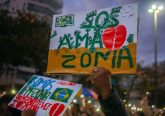“Already at 1.1-degrees of warming, we are living in an era of unmanageable loss and damage. We on the frontlines are paying the price for decades of wholly insufficient action by those most responsible for the dangerous state of our climate.” (AOSIS’ opening statement at COP27)
At the outset of the 27th Conference of the Parties (COP) to the United Nations Framework Convention on Climate Change (UNFCCC), the Alliance of Small Island States (AOSIS) made clear what they wanted to get out of this gathering under the hot November sun of Sharm el-Sheikh. They would not leave Egypt without an acceptable agreement that would reflect their decades long struggle for financial support on loss and damage. And, against all odds, developing countries achieved a historical success with the consensual decision on establishing a loss and damage fund.
Once regarded as a problem of the periphery, loss and damage has become a core concern in international climate negotiations over the years. This shift in perspective – in both political and public spheres – is, I argue, a function of both the success and the shortcomings of international climate negotiations. Giving a brief (but non-exhaustive) account of the loss and damage negotiations under the UNFCCC, I show how the core/periphery metaphor can be used to make sense of this paradox.
The term “loss and damage” first emerged in the context of the negotiations for the framework convention in the early 1990s. A proposal brought forward by Vanuatu on behalf of AOSIS requested the inclusion of an “insurance pool” that “should be used to compensate the most vulnerable small island and low-lying coastal developing countries for loss and damage resulting from sea level rise” with the costs being borne by “industrialized developed countries” (INC, 1991, 2-3). This idea marked the starting point of what would be a long, tireless struggle of developing countries – with AOSIS leading much of the way – over questions of compensation, liability and historic responsibility vis-à-vis the emerging evidence on anthropogenic climate change (see e.g. Calliari, 2018).
While the term loss and damage did not make it into the original convention text from 1992, the idea of accounting for loss and damage in an insurance context re-emerged in UNFCCC negotiations in the early 2000s, advocated mainly by countries most vulnerable to sea level rise and related climate impacts (Vanhala & Hestbaek, 2016, 115). At the time, loss and damage was a peripheral concern, experienced by those at the frontlines of climate change, and deliberately ignored by developed countries responsible for it. Being haunted by the “ghost of compensation” (Calliari et al., 2020, 5), it took 13 COPs for the term to be mentioned in a UNFCCC decision text for the first time – in the context of adaptation action under the Bali Action Plan (Roberts & Huq, 2015, 150). This certainly had to do with the more orchestrated advocacy efforts of civil society (Vanhala & Hestbaek, 2016, 116) as well as the realisation that “even a combination of mitigation and adaptation cannot prevent the impacts of climate change from manifesting, especially in vulnerable countries” (Roberts & Huq, 2015, 149).
At COP16 in Cancun in 2010, Parties were able to agree on the establishment of a work programme for L&D under the UNFCCC, which paved the way for the eventual establishment of the “Warsaw International Mechanism for Loss and Damage associated with Climate Change Impacts” (WIM) at COP19 in Warsaw (Roberts & Huq, 2015, 150-152) – a novel “institutionalized policy space” to address loss and damage (Vanhala & Hestbaek, 2016, 112). This decisive diplomatic achievement has been credited to the tireless efforts of developing countries with AOSIS at the core (Calliari, 2018, 735) (for more detailed insights into the negotiations and the role of AOSIS, other state- as well as non-state actors, see Hestbaek and Vanhala, 2016). While the establishment of the WIM further centred loss and damage on the global climate agenda, developed countries stood their ground against any legal claims on loss and damage, shielding themselves against questions of “culpability” or compensation through a broad and deliberately ambiguous framing of loss and damage (Vanhala & Hestbaek, 2016, 127).
The Paris Agreement, adopted at COP21 in 2015, then marked another important moment in the history of loss and damage negotiations, anchoring the Warsaw International Mechanism on Loss and Damage more permanently through Article 8 – the first stand-alone article on loss and damage under the convention (Calliari, 2018). Since the agreement, loss and damage is often (though not without contestation, see Calliari et al., 2020) regarded a third pillar under the UNFCCC next to mitigation and adaptation, i.e. a core issue for climate governance, policy and science (Calliari & Vanhala, 2022). However, this success is caveated by the fact that (1) the “tentative, cautious language” (Calliari, 2018, 738) of Art. 8 perpetuates the contested nature of loss and damage at UN level instead of clarifying it (Calliari, 2018, 739), and (2) any financial loss and damage considerations were deliberately excluded from Art. 8 in order to reach consensus among UNFCCC parties (Calliari, 2018, 741).
Since Paris, despite calls from developing countries to focus on loss and damage finance, attention under the UNFCCC was directed (or diverted?) to the establishment of further institutional structures through which to govern loss and damage (see e.g. Johansson et al., 2022). However, at COP26, AOSIS, again, advanced discussions on loss and damage proper – that is including financial considerations – by putting forward a proposal for a “standalone facility on loss and damage under the Financial Mechanism of the Convention”, supported by an ever-growing awareness of climate justice considerations among civil society and the public. Though unsuccessful in Glasgow, the proposal re-centred the issue of finance in the loss and damage negotiations.
A year later, at COP27, the G77+China group built on the COP26 momentum and tabled another fund proposal. Right at the beginning of COP27, a historic success was achieved when, for the first time, loss and damage finance became a sub-agenda item on the negotiation agenda, bestowing the topic with ever-more legitimacy. Getting an agreement on loss and damage funding was declared a “litmus test” for the success of COP27 by UN Secretary-General António Guterres himself. These developments at COP26 and COP27, I would argue, point towards the eventual (and inevitable) centrality of loss and damage in the international climate negotiations and regime. Loss and damage finance can no longer be dealt with as peripheral issue under the UNFCCC, as (evidence for) loss and damage and public awareness on climate justice issues continue to mount. COP27 also realised the operationalisation of the Santiago Network. Established at COP25 in Madrid, it is supposed to “catalyze technical assistance” for loss and damage as part of the WIM.
The COP27 agreement on a loss and damage fund can be understood – and has been celebrated – as a success. From an IR perspective, the role of AOSIS in the history of loss and damage is remarkable as it has proven over the decades that despite a lack of structural power in the negotiations, more peripheral geopolitical actors can achieve diplomatic successes in a consensus-based multilateral system (de Águeda Corneloup & Mol, 2014; Betzold, 2010; see also Calliari, 2018). But if you take a closer look at the UNFCCC mandate, some have wondered what the centrality of loss and damage means for the climate convention at large.
During COP27, at an event about loss and damage in Pakistan at the UNFCCC’s own pavilion, Saber Chowdhury, Member of Parliament in Bangladesh, looked back at the UNFCCC process and explained: for the first ten years of negotiations under the convention, Parties discussed how to mitigate climate change. Failing to deliver, Parties spent the following ten years talking about how to adapt to the climatic changes and related impacts around us. Failing to deliver again, Parties eventually turned towards loss and damage discussions. Now, failing to deliver would lead us to an impasse, both in terms of the lived realities of climate change and the ways to address them, but also regarding the future of the UNFCCC’s multilateral process. In that sense, agreeing on adequate loss and damage finance was not only a litmus test for COP27 but for the UNFCCC process at large.
In contrast to this, some have wondered whether the new centrality of loss and damage under the convention indicates its failure to deliver on the UNFCCC’s original objective to “to achieve […] stabilization of greenhouse gas concentrations in the atmosphere at a level that would prevent dangerous anthropogenic interference with the climate system. Such a level should be achieved within a time frame sufficient to allow ecosystems to adapt naturally to climate change, to ensure that food production is not threatened and to enable economic development to proceed in a sustainable manner” (UNFCCC, 1992). While it is true that the loss and damage fund only treats the symptoms instead of the cause – some of which could have been avoided through more decisive multilateral action years or decades ago – accepting and acknowledging the new centrality of loss and damage finance under the UNFCCC seems the only way forward if the era of loss and damage is also one of solidarity and climate justice.
The core/periphery perspective can be applied to make sense of the history of loss and damage negotiations in multiple ways. It illustrates how a political demand from/at the periphery developed into a multi-layered political, social and scientific concept has come to be perceived as central to the success of the climate regime, whilst simultaneously casting light on its shortcomings. The core/periphery perspective also draws our attention to the unconventional diplomatic power and strategies employed by those actors traditionally regarded geopolitical periphery (see Calliari et al., 2019 for a comprehensive analysis of the ‘structuralist paradox’ based on different IR theories). It prompts us to reconsider our spatial understanding of core and periphery as “SIDS have moved far beyond the sidelines of climate negotiations” (Rasheed, 2019, 229) in an era of loss and damage.
Bibliography
Betzold, C. (2010). ‘Borrowing’ power to influence international negotiations: AOSIS in the climate change regime, 1990–1997. Politics, 30(3), 131-148. Retrieved from https://journals.sagepub.com/doi/abs/10.1111/j.1467-9256.2010.01377.x
Calliari, E. (2018). Loss and damage: a critical discourse analysis of Parties’ positions in climate change negotiations. Journal of Risk Research, 21(6), 725-747. doi:10.1080/13669877.2016.1240706
Calliari, E., Surminski, S., Mysiak, J. (2019). The Politics of (and Behind) the UNFCCC’s Loss and Damage Mechanism. In: R. Mechler, L. Bouwer, T. Schinko, S. Surminski, and J. Linnerooth-Bayer (Eds.), Loss and Damage from Climate Change. Climate Risk Management, Policy and Governance. Springer, Cham. https://doi.org/10.1007/978-3-319-72026-5_6
Calliari, E., Serdeczny, O., & Vanhala, L. (2020). Making sense of the politics in the climate change loss & damage debate. Glob Environ Change, 64, 102133. doi:10.1016/j.gloenvcha.2020.102133
Calliari, E., & Vanhala, L. (2022). The ‘national turn’ in climate change loss and damage governance research: constructing the L&D policy landscape in Tuvalu. Climate Policy, 22(2), 184-197. doi:10.1080/14693062.2022.2027222
de Águeda Corneloup, I., & Mol, A. P. J. (2014). Small island developing states and international climate change negotiations: the power of moral “leadership”. International Environmental Agreements: Politics, Law and Economics, 14(3), 281-297. doi:10.1007/s10784-013-9227-0
INC. (1991). Vanuatu: Draft annex relating to Article 23 (Insurance) for inclusion in the revised single text on elements relating to mechanisms (A/AC.237/WG.II/Misc.13) submitted by the Co-Chairmen of Working Group II. Intergovernmental Negotiating Committee for a Framework Convention on Climate Change, Working Group II.
Johansson, A., Calliari, E., Walker-Crawford, N., Hartz, F., McQuistan, C., & Vanhala, L. (2022). Evaluating progress on loss and damage: an assessment of the Executive Committee of the Warsaw International Mechanism under the UNFCCC. Climate Policy, 22(9-10), 1199-1212. Retrieved from https://www.tandfonline.com/doi/pdf/10.1080/14693062.2022.2112935
Rasheed, A. A. (2019). Role of Small Islands in UN Climate Negotiations: A Constructivist Viewpoint. International Studies, 56(4), 215-235. doi:10.1177/0020881719861503
Roberts, E., & Huq, S. (2015). Coming full circle: the history of loss and damage under the UNFCCC. International Journal of Global Warming, 8(2), 141-157. Retrieved from https://www.inderscienceonline.com/doi/pdf/10.1504/IJGW.2015.071964
UNFCCC. (1992). United Nations Framework Convention on Climate Change. United Nations Framework Convention on Climate Change, FCCC/INFORMAL/84.
Vanhala, L., & Hestbaek, C. (2016). Framing Climate Change Loss and Damage in UNFCCC Negotiations. Global Environmental Politics, 16(4), 111-129. doi:10.1162/glep_a_00379





